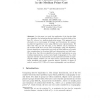102
Voted
EUROCRYPT
2006
Springer
15 years 4 months ago
2006
Springer
Abstract. Motivated by the problem of protecting cryptographic hardware, we continue the investigation of private circuits initiated in [16]. In this work, our aim is to construct ...
98
Voted
EUROCRYPT
2006
Springer
15 years 4 months ago
2006
Springer
In this paper, we develop a new attack on Damg
74
Voted
EUROCRYPT
2006
Springer
15 years 4 months ago
2006
Springer
127
click to vote
EUROCRYPT
2006
Springer
15 years 4 months ago
2006
Springer
In this paper, we study the application of the function field sieve algorithm for computing discrete logarithms over finite fields of the form Fqn when q is a medium-sized prime po...
100
Voted
EUROCRYPT
2006
Springer
15 years 4 months ago
2006
Springer
Non-interactive zero-knowledge (NIZK) proof systems are fundamental cryptographic primitives used in many constructions, including CCA2-secure cryptosystems, digital signatures, an...
67
Voted
EUROCRYPT
2006
Springer
15 years 4 months ago
2006
Springer
98
Voted
EUROCRYPT
2006
Springer
15 years 4 months ago
2006
Springer
Sequence compression is one of the most promising tools for strengthening pseudo-random generators used in stream ciphers. Indeed, adding compression components can thwart algebrai...
100
click to vote
EUROCRYPT
2006
Springer
15 years 4 months ago
2006
Springer
The Isomorphism of Polynomials (IP) [28], which is the main concern of this paper, originally corresponds to the problem of recovering the secret key of a C scheme [26]. Besides, t...
108
click to vote
EUROCRYPT
2006
Springer
15 years 4 months ago
2006
Springer
We present an Identity Based Encryption (IBE) system that is fully secure in the standard model and has several advantages over previous such systems
126
Voted
EUROCRYPT
2006
Springer
15 years 4 months ago
2006
Springer
In this work we provide efficient distributed protocols for generating shares of random noise, secure against malicious participants. The purpose of the noise generation is to crea...




